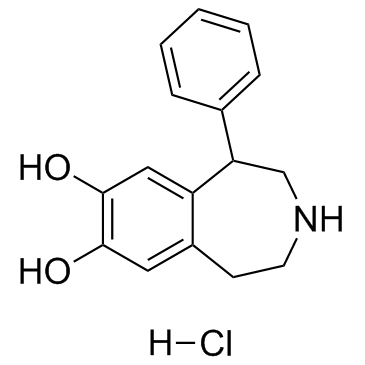SKF38393 HCl

SKF38393 HCl structure
|
Common Name | SKF38393 HCl | ||
|---|---|---|---|---|
| CAS Number | 62717-42-4 | Molecular Weight | 291.773 | |
| Density | N/A | Boiling Point | N/A | |
| Molecular Formula | C16H18ClNO2 | Melting Point | N/A | |
| MSDS | Chinese USA | Flash Point | N/A | |
| Symbol |

GHS07 |
Signal Word | Warning | |
|
Adaptation of NS cells growth and differentiation to high-throughput screening-compatible plates.
BMC Neurosci. 11 , 7, (2010) There is an urgent need of neuronal cell models to be applied to high-throughput screening settings while recapitulating physiological and/or pathological events occurring in the Central Nervous System (CNS). Stem cells offer a great opportunity in this direc... |
|
|
Inhibition of adult rat retinal ganglion cells by D1-type dopamine receptor activation.
J. Neurosci. 29 , 15001-16, (2009) The spike output of neural pathways can be regulated by modulating output neuron excitability and/or their synaptic inputs. Dopaminergic interneurons synapse onto cells that route signals to mammalian retinal ganglion cells, but it is unknown whether dopamine... |
|
|
Dopaminergic regulation of mate competition aggression and aromatase-Fos colocalization in vasotocin neurons.
Neuropharmacology 58 , 117-25, (2010) Recent experiments demonstrate that aggressive competition for potential mates involves different neural mechanisms than does territorial, resident-intruder aggression. However, despite the obvious importance of mate competition aggression, we know little abo... |
|
|
Effects of quinpirole and SKF 38393 alone and in combination in squirrel monkeys trained to discriminate cocaine.
Psychopharmacology 107 , 217, (1992) The present study was designed to assess the behavioral similarity of the effects of prototype dopamine receptor-subtype selective agonists and cocaine. Squirrel monkeys (N = 4) were trained with food reinforcement to press one of two levers after administrat... |
|
|
Stimulation of dopamine D-1 receptors by SKF 38393 induces EEG desynchronization and behavioral arousal.
Life Sci. 37 , 2327, (1985) The dopamine D-1 receptor agonist SKF 38393 dose-dependently (2.5-10 mg/kg) induced desynchronization of the electroencephalographic (EEG) activity and behavioral arousal in both rabbits and rats. Unlike apomorphine, SKF 38393 elicited no signs of stereotyped... |